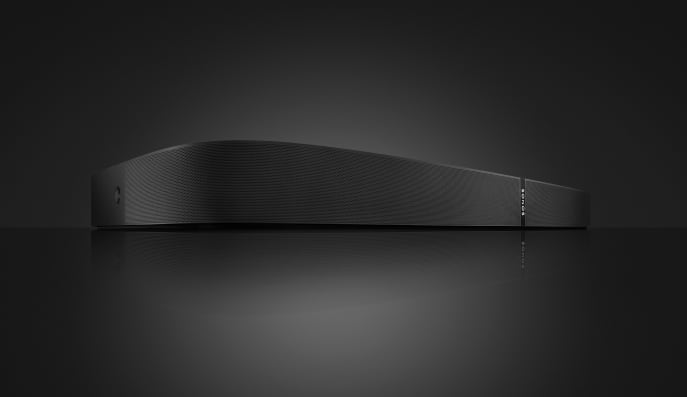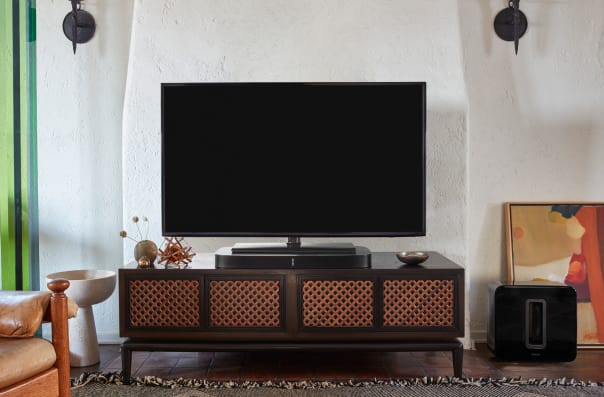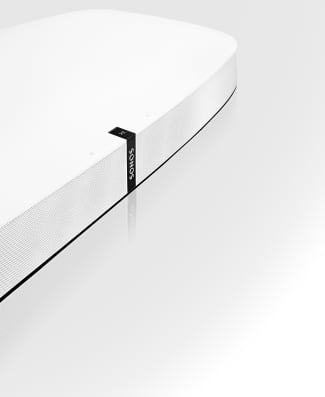Sonos’s Weird-Looking New Speaker Solves A Living Room Design Problem
Like many consumer products, Sonos’s newest smart speaker began with plenty of consumer research. But in studying the way that people live and interact with entertainment technology at home, the company discovered a fact that seemed to undermine its own approach: Most people—a full 70%, by Sonos’s count—do not mount their television sets on the wall, preferring to sit them on top of a piece of furniture instead. It’s a statistic that contradicts the popularity of home theater sound bars like Sonos’s own Playbar, which tend to be designed with the wall-mounted setup in mind. At the same time, it suggested an opportunity.
After countless iterations, testing and retunings, the Sonos Playbase was born. The 58-millimeter-high device doesn’t look much like a speaker, but it packs all the sonic fidelity of other Sonos products like the Playbar and Play:5. The new Wi-Fi-enabled speaker, which starts shipping on April 4th, takes on a somewhat odd, oblong, flat shape designed to sit comfortably and inconspicuously beneath most standard television sets.
“Designers are a little bit uncomfortable with a design being underneath something,” says Sonos VP of Design Tad Toulis, of the Playbase’s unusual form factor. “But every other solution ended up like a game of Twister, where you were always upside down on some dimension of the problem. When you’re fighting that hard for something, there’s probably something telling you you’re approaching it wrong.”

Like the other speakers in Sonos’s lineup, the Playbase comes in either black or white. The idea, as is often the case in product design, is to allow the speakers to almost be invisible, fading into the background while the consumer focuses on what really matters: the sound. Or, in this case, the sound combined with imagery on a large screen.
“When you’re drinking a really great glass of wine, it’s the wine,” says Toulis. “You’re not like, this was a really great glass. Your focus is on what you’re swallowing and tasting. We have the same thing. You should be digesting the sound and the music.”
The development of the Playbase comes at a crucial—and, it might seem, somewhat counterintuitive–time for the company. After the surprisingly explosive success of Amazon’s Echo (and quick proliferation of voice-controlled smart speakers), Sonos finds itself under competitive pressure.
While the Echo is not focused on high-fidelity or multi-room wireless audio the way that Sonos is, this new category of speakers nonetheless caused the company to rethink its priorities. Sonos, which is now led by CEO Patrick Spence after longtime chief executive John MacFarlane stepped down earlier this year, is now focused on building integrations with voice control providers, starting with Amazon’s Alexa platform. It’s also working on building out a developer platform of its own to make third-party integrations easier to develop down the road. As the company’s executives are quick to point out, the Playbase is just one of the projects its engineers and designers have been focused on over the last several months.
Packed inside the Playbase’s thin profile is a 10-driver speaker system that creates a very wide, immersive soundstage that’s optimized for both music and movies. Naturally, the Playbase pairs wirelessly with other Sonos speakers like the Play:5, Play:1, and Sub, allowing home theater audio freaks to splurge and set up a wireless surround sound system if so desired. Since it relies on Sonos’s proprietary, Wi-Fi-based infrastructure rather than standard audio inputs and outputs, the Playable can’t be paired with speakers from other brands. Still, even without add-on speakers the $700 Playbase (priced the same as the Playbar) does quite a bit of justice to the film audio and music on its own—and like other Sonos speakers, it can be automatically tuned to an individual room using the company’s iOS-based acoustic tuning feature TruePlay.
The high-fidelity sound of the Playbase is owed, at least in part, to Giles Martin. For the last few years, the recording engineer and son of the late “fifth Beatle” Sir George Martin has worked for Sonos as the company’s sound experience leader, working with its acoustics team to ensure that Sonos products adhere to the exacting standards of the creativity community. Historically, that has meant taking Sonos’s music-focused speakers like the Play:5 to record producers like Rick Rubin (who sits on the company’s board) and Radiohead’s Nigel Godrich, among many others. But with the Playbase, Martin’s job was a bit more complicated. Not only did hit records need to sound ideal, but so did the more multifaceted and nuanced audio of Hollywood films, complete with not just music but dialogue and sound effects as well. For Martin, the challenge was ensuring that the device’s 10 speaker drivers fire the right sounds in the right directions across a wide range of home entertainment scenarios—whether you’re listening to Adele or watching Mad Max: Fury Road.

To do that, Martin had to track down the people who mixed and engineered the audio for Hollywood blockbusters—like Max Max’s Chris Jenkins and The Revenant‘s sound mixer, Jon Taylor—and get their feedback on how the Playbase represented their work.
“It becomes very precise,” says Martin of the process of working with film audio engineers. “Jon Taylor said that in The Revenant that the river needs to sound angry. This voice needs to come from here. There’s a drum in the opening battle scene and he was very particular about how that drum should sound. You’ll talk to effects specialists about explosions and things like that.”
Much like interfacing with record producers, working with Hollywood sound editors involves a lot of back and forth, lugging speaker prototypes to film studios and people’s offices and typically leaving with a list of complaints and demands, which are then balanced with the scientific constraints of the acoustics team and the aesthetic preferences of Toulis and the design team.
“Generally, if you tick all those boxes, you wind up with a product that works for everything,” says Martin.
With the industry audio gurus satisfied, the new speaker is now ready to find its way onto consumers’ entertainment units, where Toulis hopes it will practically disappear altogether.
“That’s what good design does,” says Toulis. “It can still be elegant. I have some nice pieces of furniture, but they’re comfortable. It’s not like they’re beautiful and uncomfortable. When I’m in it, I’m not thinking about how it looks. That’s the role of design.”



Fast Company , Read Full Story
(55)






